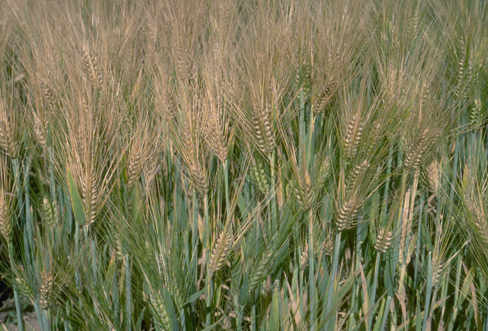Barley
Barley (Hordeum vulgare), a cereal grain in the grass family, is used as a livestock feed and in foods (e.g. cereals and soups) for human consumption. Barley is also converted into malt for brewing, distilling, and various other products (e.g. malted milk). Some growers use smooth-awn or awnless varieties in hay production. While barley production has declined over the years, there has recently been a renewed interest in this crop. Because barley is harvested earlier than wheat, double-cropped soybeans can be planted earlier, resulting in higher soybean yields. Hulless barley (Hordeum vulgare var. nudum) has also been generating considerable interest.
Marketing
Barley is produced commercially in Kentucky for livestock feed. Marketing barley straw may increase profitability for the crop. Some growers have sold small amounts of barley for local use in backyard poultry production. Barley production area has declined in the Eastern Corn Belt and Mid-South states due to increased profitability of corn, soybeans, and wheat. Barley prices are usually significantly lower than wheat prices. Nationally, the quantity of barley demanded by food and feed manufacturers is steady to slightly increasing. This increase is attributed to 1) increased interest in whole grain food ingredients in breakfast cereals and other foods; and 2) a search for lower-priced grains by the swine and poultry industries. However, the increase in the quantity of barley demanded has not been accompanied by a great enough increase in barley price to attract more production in Kentucky and nearby states. Additionally, higher-yielding barley varieties have more than compensated for any recent demand increase; fewer barley acres were harvested in the U.S. in 2011 than in any year since the 1930s Dust Bowl Era. This lack of a cash market has limited barley production in the Commonwealth.
Production
 Barley prefers well-drained, loamy soils and will not tolerate waterlogged conditions. Both yields and grain quality are reduced on poorly drained sites. Barley is less winter hardy than wheat and is very sensitive to acid soils; soil pH should be 6.0 or above. Yield potential, disease resistance, and maturity are the critical considerations in cultivar selection. Growers need to be aware of the most commonly occurring diseases on or near their farm and then choose high yielding resistant varieties accordingly. Other varietal considerations include straw strength and grain plumpness. Use certified seed or seed of proven high quality from an established, reputable dealer. Seed should be fungicide-treated to protect against loose smut and seedling diseases. The University of Kentucky Small Grain Variety Testing Program conducts research on hulless and traditional hulled barley. Important aspects of this research include evaluating experimental barley breeding lines and variety testing of commercially available barley varieties. Barley variety performance and evaluation of breeding lines are available at the UK Small Grain Variety Testing Web site.
Barley prefers well-drained, loamy soils and will not tolerate waterlogged conditions. Both yields and grain quality are reduced on poorly drained sites. Barley is less winter hardy than wheat and is very sensitive to acid soils; soil pH should be 6.0 or above. Yield potential, disease resistance, and maturity are the critical considerations in cultivar selection. Growers need to be aware of the most commonly occurring diseases on or near their farm and then choose high yielding resistant varieties accordingly. Other varietal considerations include straw strength and grain plumpness. Use certified seed or seed of proven high quality from an established, reputable dealer. Seed should be fungicide-treated to protect against loose smut and seedling diseases. The University of Kentucky Small Grain Variety Testing Program conducts research on hulless and traditional hulled barley. Important aspects of this research include evaluating experimental barley breeding lines and variety testing of commercially available barley varieties. Barley variety performance and evaluation of breeding lines are available at the UK Small Grain Variety Testing Web site.
See the full crop profile and other resources below:

